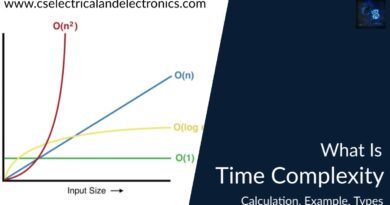Top 20 Algorithms Electrical And Electronics Engineers Must Know
Hello guys, welcome back to our blog. Here in this article, we will discuss the top 20 algorithms electrical and electronics engineers must know, we will also share the purpose of using those algorithms with a short and sweet explanation.
If you have any electrical, electronics, and computer science doubts, then ask questions. You can also catch us on Instagram – CS Electrical & Electronics.
Also, read:
- What Is ECU In Vehicles, Electronic Control Unit, Purpose, Types
- Top 20 Real-Time Power System Monitoring Software
- Top 20 Latest Innovations In VLSI Domain, VLSI Technologies
Algorithms Electrical And Electronics Engineers
Electrical and electronics engineers should learn these algorithms for several reasons:
- These algorithms are commonly used in various fields such as signal processing, control systems, communication systems, machine learning, and optimization. Therefore, understanding these algorithms is essential for electrical and electronics engineers to be able to design and analyze systems in these fields.
- Many of these algorithms are used in real-time applications, where high computational efficiency is crucial. Electrical and electronics engineers need to understand these algorithms to develop efficient implementations and optimize their performance.
- Learning these algorithms can help electrical and electronics engineers to improve their problem-solving skills and develop a deeper understanding of mathematical concepts and their applications.
- These algorithms are the building blocks for developing advanced applications and systems such as autonomous vehicles, robotics, and smart grids. By understanding these algorithms, electrical and electronics engineers can contribute to the development of these advanced systems.
- Finally, as technology continues to advance and new applications emerge, it is essential for electrical and electronics engineers to stay up-to-date with the latest algorithms and techniques in their field.
Top 20 Algorithms Electrical And Electronics Engineers
20. Maximum Likelihood Estimation (MLE): A statistical technique used to estimate the parameters of a probability distribution by maximizing the likelihood function. MLE is used in applications such as signal processing, communications, and control systems.
19. Recursive Least Squares (RLS): A variation of the least-squares optimization algorithm that is used for the online estimation of system parameters. RLS is commonly used in adaptive filtering and system identification applications.
18. Expectation Maximization (EM): A statistical algorithm used to estimate the parameters of a model with latent variables. EM is commonly used in applications such as image and signal processing, pattern recognition, and machine learning.
17. Support Vector Machines (SVM): A set of algorithms used for classification and regression analysis. SVMs are commonly used in machine learning applications such as image classification, text classification, and bioinformatics.
16. Hidden Markov Models (HMM): A statistical model used to represent the probability distribution over a sequence of observations that are generated by a process with hidden states. HMMs are used in applications such as speech recognition, bioinformatics, and robotics.
15. Discrete Cosine Transform (DCT): A variant of the Fourier Transform used in signal processing and image compression. The DCT is used in applications such as JPEG image compression and MPEG video compression.
14. Wavelet Transform: A mathematical technique used for signal and image processing, which is particularly useful for analyzing signals with varying frequency content over time. The Wavelet Transform is used in applications such as image compression, noise reduction, and feature extraction.
13. Nonlinear Optimization: A mathematical technique used to find the minimum or maximum value of a function subject to constraints, which is commonly used in engineering design and optimization problems.
12. Artificial Neural Networks (ANN): A set of algorithms inspired by the structure and function of biological neural networks, which are used for machine learning and pattern recognition applications such as speech recognition, image classification, and predictive maintenance.
11. Principal Component Analysis (PCA): A technique used to reduce the dimensionality of a dataset by finding the principal components that capture the most important information in the data. PCA is used in applications such as feature extraction, data compression, and data visualization.
10. Least-Squares Optimization: A mathematical technique used to find the best fit between a set of data points and a mathematical model, which is commonly used in curve fitting and system identification.
09. Genetic Algorithm: An optimization algorithm inspired by the process of natural selection, which is commonly used in engineering design and optimization problems.
08. Particle Swarm Optimization (PSO): An optimization algorithm inspired by the behavior of swarms of particles, which is commonly used in optimization problems such as parameter tuning, function optimization, and control systems.
07. Backpropagation: An algorithm used in artificial neural networks to train the network by adjusting the weights of the connections between the neurons.
06. K-Means Clustering: A clustering algorithm used to partition a set of data points into groups or clusters based on their similarity, which is commonly used in image processing and pattern recognition.
05. Fast Fourier Transform (FFT): A widely-used algorithm for computing the Discrete Fourier Transform (DFT) of a signal, which is used in a wide range of applications, including signal processing, communications, and control systems.
04. Kalman Filter: A mathematical algorithm used for estimating the state of a dynamic system based on a series of measurements. It is commonly used in control and signal processing applications where there is uncertainty in the system measurements.
03. Singular Value Decomposition (SVD): A mathematical technique used to decompose a matrix into its constituent parts, which can be used for applications such as data compression, image processing, and signal processing.
02. Monte Carlo Simulation: A method for generating random samples of a system to estimate its behavior or performance, which is commonly used in the modeling and simulation of electrical and electronic systems.
01. Convolution: A mathematical operation that combines two functions to produce a third function, which is commonly used in signal processing, control systems, and communication systems.
This was about “Algorithms Electrical And Electronics Engineers“. I hope this article may help you all a lot. Thank you for reading.
Also, read:
- 10 Tips To Maintain Battery For Long Life, Battery Maintainance
- 10 Tips To Save Electricity Bills, Save Money By Saving Electricity
- 100 (AI) Artificial Intelligence Applications In The Automotive Industry
- 100 + Electrical Engineering Projects For Students, Engineers
- 1000+ Control System Quiz, Top MCQ On Control System
- 1000+ Electrical Machines Quiz, Top MCQs On Electrical Machines
- 1000+ Electronics Projects For Engineers, Diploma, MTech Students
- 1000+ MATLAB Simulink Projects For MTech, Engineering Students
Author Profile
- Chetu
- Interest's ~ Engineering | Entrepreneurship | Politics | History | Travelling | Content Writing | Technology | Cooking
Latest entries
 All PostsApril 19, 2024What Is Vector CANoe Tool, Why It Is Used In The Automotive Industry
All PostsApril 19, 2024What Is Vector CANoe Tool, Why It Is Used In The Automotive Industry All PostsApril 13, 2024What Is TCM, Transmission Control Module, Working, Purpose,
All PostsApril 13, 2024What Is TCM, Transmission Control Module, Working, Purpose, All PostsApril 12, 2024Top 100 HiL hardware in loop Interview Questions With Answers For Engineers
All PostsApril 12, 2024Top 100 HiL hardware in loop Interview Questions With Answers For Engineers All PostsMarch 22, 2024Driver Monitoring Systems In Vehicles, Working, Driver Sleepy Alert
All PostsMarch 22, 2024Driver Monitoring Systems In Vehicles, Working, Driver Sleepy Alert








